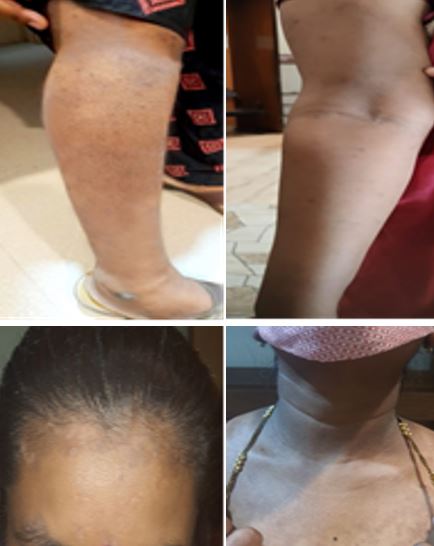Management of Plaque Psoriasis with Multimodal Treatment of Ayurveda - A Case Report
DOI:
https://doi.org/10.21760/jaims.9.8.35Keywords:
Plaque Psoriasis, Virechana, Basti, Shamana Chikitsa, Case ReportAbstract
Psoriasis is the immune system problem that causes skin to revitalize at faster rate. It’s the chronic disease that has psychological and social impact on patient’s life. This condition had been narrated many decennium ago but proper aetiology and its cure remain under researched. In Ayurveda this multifaceted etiology disease needs multimodal treatment. The modern treatment provides only temporary relief with too many serious side effects. The treatment embraced here was in accordance with ayurvedic Samprapti. This case report details the successful management of plaque psoriasis in a 32-year-old female patient using a multimodal treatment approach, which incorporated Panchakarma, a traditional Ayurvedic detoxification therapy. The patient presented with erythematous plaques on forehead, neck region, lateral surface of legs and at arms along with itchy and burning skin. Auspitz sign and Koebner phenomenon was positive. Diagnosis made on the basis of Sign and Symptoms. After a thorough evaluation of the patient's constitution and the nature of the disease, a customized Panchakarma protocol was devised involving Virechana (Purgation) followed by Basti (medicated enema) along with Shamana Chikitsa (Internal Medication). The results revealed a remarkable improvement in the patient's psoriasis lesions, with a significant reduction in PASI scores, reduction in scaling, erythema, and in duration. The patient reported a substantial reduction in itching and discomfort. This case report emphasizes the potential of Panchakarma as an adjunctive therapy for plaque psoriasis, highlighting the holistic and personalized approach of Ayurveda in managing chronic skin conditions. Further research and larger-scale studies are warranted to confirm the effectiveness of Panchakarma in the treatment of psoriasis and to observe its long-term benefits and safety profile.
Downloads
References
DM T, M M. Research on psoriasis in India: Where do we stand? Indian J Med Res. 2017;146(2):147–9.
Griffiths CEM, Armstrong AW, Gudjonsson JE, Barker JNWN. Psoriasis. Lancet. 2021;397:1301–15.
Nille GC, Chaudhary AK. Potential implications of Ayurveda in Psoriasis : A clinical case study. J Ayurveda Integr Med [Internet]. 2021;12:172–7. Available from: https://doi.org/10.1016/j.jaim.2020.11.009
Fauci AS, Braunwald E, Kasper DL, Hauser SL, Longo DL. Harrison’s principles of internal medicine. 17th ed. Newyork: McGraw Hill Education; 2008. 316 p.
Pandit Kashinath Shastri (reprint edition), Charak chikitsa Sthana, Kustha chikitsa adhyaya-chapter 7, Varanasi; Chaukhambha prakashana, 2006; 203.
Lowes MA, Suarez-Farinas M, Krueger JG. Immunology of Psoriasis. Annu Rev Immunol. 2014;32:227–55.
Telles S, Pathak S, Kumar A, Mishra P, Balkrishna A. Ayurvedic Doshas as Predictors of Sleep Quality. Med Sci Monit. 2015;21:1421–7.
https://www.theayurveda.org/ayurveda/psoriasis-symptoms-cause-types..Date-20/11/2023.Time 16:00 IST.
Pandey RK, Bhatt NN, Singhala TM, Shukla VD. A comparative study of Vamana and Virechana Karma in the management of Sthula Pramehi w.s.r. to Type ‑ 2 diabetes. Ayu. 2011;32(4):536–9.
Doddagoudar S, Patil P. A Clinical study on the Efficacy of Virechana karma followed by Pathyadi lepa in the management of Kitibha kushta w.s.r to Psoriasis. RGUHS J AYUSH Sci. 2018;5(2):2–6.
Kumar KK, Chacko J. Thuvaraka rasayana regimen in Psoriasis vulgaris - A case report. J Ayurveda Integr Med [Internet]. 2019;10:41–4. Available from: https://doi.org/10.1016/j.jaim.2018.04.003
Kadam D, Suryakar AN, Ankush R, Kadam C, Deshpande K. Role of Oxidative Stress in Various Stages of Psoriasis. Indian J Clin Biochem. 2010;25(4):388–9
Upadhyay AK, Kumar K, Kumar A, Mishra HS. Tinospora cordifolia (Willd.) Hook. f. and Thoms. (Guduchi) – validation of the Ayurvedic pharmacology through experimental and clinical studies. Int J Ayurveda Res. 2010;1(2):112–21.
Kumar G, Srivastava A, Sharma SK, Gupta YK. Safety evaluation of an Ayurvedic medicine, Arogyavardhini vati on brain , liver and kidney in rats. J Ethnopharmacol. 2012;140(1):151–60.
Karki A, Yalagond MS, Illal V. A Comparative Study on the effect of Padabhyanga with Tila Taila and Nimba Taila in management of Vipadika w. s. r. to Padasputana. J Ayurveda Integr Med Sci. 2018;3(4):18–23.















